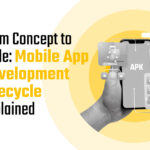Abstract
This case study delves into the detailed development process of an omnichannel chatbot designed to provide a consistent and personalized customer experience across various platforms. The primary objective is to create a versatile chatbot that seamlessly integrates with multiple communication channels, including websites, mobile apps, and social media platforms. This case study outlines the key steps involved in the development process. It demonstrates the effectiveness of the omnichannel chatbot in enhancing customer engagement and satisfaction.
omnichannel chatbot :Introduction
In the current digital landscape, businesses strive to engage customers across different platforms effectively. An omnichannel chatbot is a virtual assistant enabling firms to offer round-the-clock support, personalized recommendations, and instant responses. This case study focuses on the detailed development of such a chatbot, which can be effortlessly integrated across all platforms.
Objectives
The primary goals of developing an omnichannel chatbot are:
a) Seamless integration:
- Seamless integration refers to the ability of the chatbot to work smoothly and cohesively across various platforms.
- It ensures that the chatbot’s functionality, features, and user experience remain consistent regardless of the platform used.
- The chatbot should be able to handle user queries, provide accurate responses, and offer the same level of assistance and engagement across all platforms.
- Connectors and APIs (Application Programming Interfaces) are created to facilitate effective communication between the chatbot and different platforms.
- These connectors and APIs enable the chatbot to receive user inputs, process them, and deliver relevant responses across all integrated platforms.
- Seamless integration provides a consistent user experience, allowing users to access the chatbot from their preferred platform and receive the same level of support and assistance.
- Users can initiate conversations on one platform and seamlessly continue them on another platform without disruptions or inconsistencies.
- Seamless integration enhances customer satisfaction and engagement by ensuring a seamless and uninterrupted user experience.
b) Personalized customer experience:
- Personalized customer experience refers to customizing the chatbot’s responses and interactions to meet individual customers’ specific needs and preferences.
- The chatbot analyzes and considers factors such as customer preferences, purchase history, and browsing behavior.
- By understanding customer preferences, the chatbot can provide recommendations, suggestions, and solutions that align with their interests and needs.
- The chatbot utilizes customer purchase history to offer personalized product recommendations, promotions, or relevant information.
- Browsing behavior analysis helps the chatbot understand customer interests, enabling it to suggest relevant content or guide customers toward their desired information.
- Tailored responses enhance the customer experience by providing relevant and valuable information, increasing customer satisfaction and engagement.
- Personalized customer experience helps build a stronger connection between the customer and the chatbot, fostering customer loyalty and trust.
- By delivering tailored responses, the chatbot can anticipate and fulfill customer needs, improving the customer journey and fostering a positive impression of the business.
- The chatbot’s ability to provide personalized experiences contributes to more engaging and satisfying customer interaction, ultimately increasing customer loyalty and retention.
c) Improved customer engagement:
- Improved customer engagement refers to the chatbot’s ability to involve customers in meaningful interactions and provide higher satisfaction actively.
- The chatbot achieves this by offering instant assistance, allowing customers to receive timely responses and support without delays.
- By providing instant assistance, the chatbot eliminates the need for customers to wait for human aid, resulting in quicker issue resolution and improved customer satisfaction.
- The chatbot is also crucial in delivering relevant customer information based on their queries or needs.
- The chatbot can provide accurate and up-to-date information through its knowledge base and access to relevant data, ensuring that customers receive the most pertinent and valuable responses.
- The chatbot’s ability to deliver relevant real-time information enables customers to make informed decisions and find solutions more efficiently.
- By engaging customers promptly and informally, the chatbot enhances their overall experience, leading to increased satisfaction and a positive impression of the brand or business.
- Improved customer engagement through the chatbot’s instant assistance and relevant information builds stronger customer relationships and loyalty.
- Customers appreciate the convenience and efficiency of interacting with a chatbot that can quickly address their needs and provide valuable information.
- Overall, the chatbot’s role in improving customer engagement leads to higher levels of satisfaction, increased customer retention, and positive word-of-mouth referrals.
Methodology
The development of the omnichannel chatbot follows these key steps:
a) Requirement gathering:
- Requirement gathering is the initial stage of the chatbot development process, where the focus is on understanding the business’s specific needs.
- The goal is to identify the functionalities and features the chatbot should have across different platforms.
- The development team discusses and consults with the business stakeholders to gather insights into their requirements and expectations.
- The team seeks to understand the business’s unique challenges, customer pain points, and areas where the chatbot can provide value and assistance.
- By gathering these requirements, the team can determine the scope and objectives of the chatbot development project.
- The requirement-gathering process involves interviews, surveys, or workshops with key stakeholders to gather their input and perspectives.
- The team analyzes existing customer support processes and identifies areas where the chatbot can streamline operations and improve efficiency.
- During this phase, the team also considers the integration requirements with various platforms, such as websites, mobile apps, and social media channels.
- The team collaborates with stakeholders to define specific use cases and scenarios for deploying the chatbot.
- Clear documentation of the requirements is essential to ensure that the development team and stakeholders understand the project goals and objectives.
- The requirement-gathering process lays the foundation for the subsequent design and development stages, ensuring the chatbot aligns with the business’s specific needs and objectives.
b) Design and architecture:
- Design and architecture refer to creating a robust and well-structured framework for the chatbot’s development.
- The focus is on designing an architecture that supports seamless integration with various platforms and ensures efficient data flow between the chatbot and backend systems.
- The development team designs the overall structure of the chatbot, including its components, modules, and interconnections.
- The architecture is strategically devised to facilitate effortless integration with various platforms, including websites, mobile applications, and social media channels.
- The architecture should be scalable and flexible to handle potential future changes and accommodate growth in user interactions.
- The team defines the data flow between the chatbot and the backend systems, ensuring a smooth exchange of information and responses.
- It involves designing APIs (Application Programming Interfaces) and connectors that enable the chatbot to communicate with the backend systems.
- Security and privacy considerations are incorporated into the design and architecture to protect user data and ensure compliance with regulations.
- The architecture may include components for natural language processing (NLP), machine learning algorithms, and knowledge bases to enable accurate and intelligent interactions.
- The design and architecture phase requires collaboration between developers, system architects, and stakeholders to ensure alignment with business requirements.
- Documentation and diagrams are created to illustrate the architecture and provide a clear understanding of the system’s design and its integration capabilities.
The design and architecture phase is crucial for laying the foundation of the chatbot’s development, enabling seamless integration with platforms, and ensuring efficient data exchange, ultimately contributing to the chatbot’s overall performance and effectiveness.
c) Natural Language Processing (NLP):
- Natural Language Processing (NLP) encompasses the study and application of techniques that empower computers to comprehend and interpret human language in a manner akin to human beings.
- Implementing NLP techniques in the chatbot allows it to understand and interpret user queries and respond appropriately and accurately.
- NLP techniques include language understanding, sentiment analysis, named entity recognition, and intent classification.
- The chatbot utilizes NLP algorithms and models to analyze and extract meaning from user inputs, including text or voice-based queries.
- NLP enables the chatbot to identify the intent or purpose behind user queries, allowing it to provide relevant and contextual responses.
- By understanding user queries accurately, the chatbot can better assist users, answer their questions, and provide appropriate information or solutions.
- NLP also helps the chatbot handle variations in the user language, including different sentence structures, slang, or grammatical errors.
- Implementing NLP involves training the chatbot on large datasets to improve its language understanding capabilities.
- The chatbot learns from patterns and examples in the data to improve its accuracy in understanding and responding to user queries.
- NLP models can be customized and fine-tuned based on the specific domain or industry of the chatbot, enhancing its performance and relevance.
- Integrating NLP techniques empowers the chatbot to engage in more natural and meaningful conversations with users, leading to a better user experience.
By implementing NLP techniques, the chatbot becomes more adept at understanding and responding to user queries accurately, improving the overall quality of interactions and user satisfaction.
d) Platform integration:
- Platform integration entails the smooth and seamless incorporation of the chatbot into diverse platforms, including websites, mobile applications, and social media channels.
- The objective is to enable users to interact with the chatbot from their preferred platform and provide a consistent user experience across all integrated channels.
- Building connectors and APIs (Application Programming Interfaces) is crucial in achieving seamless integration.
- Connectors and APIs bridge the chatbot and the platforms it is integrated with, facilitating communication and data exchange.
- Connectors are specific components that establish a connection between the chatbot and each platform, allowing the chatbot to send and receive information.
- APIs define rules and protocols for the chatbot to interact with the platform’s functionalities, data, and services.
- Connectors and APIs are developed using programming languages and frameworks compatible with the integrated platforms.
- The connectors and APIs ensure that the chatbot can receive user inputs, process them, and provide responses on the respective platforms.
- The chatbot uses APIs to access platform-specific features and services, such as retrieving user information, performing actions, or accessing data from backend systems.
- The development team works closely with the platform providers to understand their APIs and develop connectors that adhere to their specifications.
- Platform integration allows users to interact with the chatbot seamlessly without switching between different applications or websites.
- Seamless integration enhances the user experience by providing a consistent interface and functionality, regardless of the platform used.
By building connectors and APIs for platform integration, the chatbot becomes accessible and functional across various platforms, improving convenience for users and providing a cohesive experience throughout their interactions.
e) Testing and optimization:
- Testing and optimization are crucial steps in the chatbot development process to ensure flawless performance across all platforms.
- Rigorous testing is conducted to identify and resolve any issues or bugs that may affect the chatbot’s functionality or user experience.
- Testing involves simulating various user interactions and scenarios to evaluate the chatbot’s responses and behavior.
- Testing is performed on each integrated platform to verify that the chatbot functions as intended and provides consistent results.
- Different types of testing, such as functional, performance, and usability, are carried out to assess various aspects of the chatbot’s performance.
- Functional testing ensures that the chatbot accurately understands user queries and provides appropriate responses.
- Performance testing assesses the chatbot’s speed, responsiveness, and scalability, ensuring it can handle a high volume of user interactions without performance degradation.
- Usability testing involves gathering user feedback to evaluate the chatbot’s user experience and identify areas for improvement.
- User feedback is collected and analyzed to gain insights into the chatbot’s strengths, weaknesses, and areas where optimization is required.
- Continuous optimization enhances the chatbot’s performance and user satisfaction based on user feedback and testing results.
- Optimization may involve fine-tuning the chatbot’s NLP models, updating its knowledge base, or refining its response generation algorithms.
- Iterative testing and optimization cycles are conducted to address any identified issues, enhance the chatbot’s capabilities, and improve its overall performance.
- Consistent monitoring and maintenance are vital to uphold the chatbot’s functionality and optimize its performance, adapting to evolving user needs and preferences.
By conducting rigorous testing and continuous optimization, the chatbot can deliver a flawless user experience, meet user expectations, and adapt to changing requirements, ultimately providing an efficient and effective solution for users across all platforms.
Implementation
a) Platform integration:
- Platform integration involves integrating the chatbot into desired platforms, such as websites and social media channels.
- The objective is to ensure the chatbot can seamlessly interact with users across these platforms, providing a consistent user experience.
- Developing connectors and APIs is essential for smooth integration and communication between the chatbot and the platforms.
- Connectors and APIs serve as bridges that enable the chatbot to send and receive data from the integrated platforms.
- Connectors are specific components or modules that establish a connection between the chatbot and each platform it is integrated with.
- APIs (Application Programming Interfaces) define rules and protocols that allow the chatbot to interact with the platform’s functionalities and services.
- Developing connectors and APIs involves utilizing programming languages and frameworks compatible with the integrated platforms.
- Connectors and APIs ensure the chatbot can receive user inputs, process them, and respond appropriately on the platforms.
- Connectors enable the chatbot to access platform-specific features and functionalities, ensuring a seamless and integrated user experience.
- APIs facilitate data exchange between the chatbot and the integrated platforms, enabling the chatbot to retrieve relevant information and perform platform-specific actions.
- Developing connectors and APIs requires close collaboration with platform providers to understand and integrate their specifications.
- The development team ensures that the connectors and APIs are robust, reliable, and secure to support smooth communication and data transfer.
- Platform integration through connectors and APIs ensures that users can access and interact with the chatbot seamlessly across multiple platforms, enhancing convenience and consistency.
The chatbot can seamlessly integrate with desired platforms by developing connectors and APIs for platform integration, providing a unified and consistent user experience regardless of the medium used.
b) NLP implementation:
- NLP implementation refers to incorporating NLP techniques into the chatbot to enable it to understand and respond to user queries accurately.
- NLP is an area of research that centers on empowering computers to comprehend and make sense of human language in a manner that carries significance.
- The chatbot is trained using machine learning algorithms and pre-built NLP models to enhance its language understanding capabilities.
- Machine learning algorithms analyze large datasets to identify patterns and relationships within the data, enabling the chatbot to learn from examples and improve its performance over time.
- Pre-built NLP models serve as a foundation for the chatbot’s language understanding capabilities, providing a starting point for training and customization.
- The chatbot is trained on specific datasets relevant to its domain or industry, allowing it to understand industry-specific terminology and user intents.
- During the training process, the chatbot learns to recognize different elements of user queries, such as intents, entities, and sentiment, to generate accurate and contextually appropriate responses.
- NLP techniques extract valuable information from user queries, including named entity recognition, sentiment analysis, and intent classification.
- The chatbot utilizes these NLP techniques to identify user queries’ purpose or intent and extract relevant entities or information.
- The training process involves iterative training cycles, validation, and fine-tuning to improve the chatbot’s accuracy and performance.
- The development team continuously evaluates the chatbot’s performance, adjusting and refining the NLP models to address weaknesses or limitations.
- The training data utilized for the chatbot can be sourced from various channels, encompassing historical customer interactions, user feedback, and carefully curated datasets.
- As the chatbot interacts with users and receives feedback, it incorporates user interactions into its training data to improve understanding and responses.
By implementing NLP techniques and training the chatbot, it becomes capable of effectively understanding user queries and generating accurate and contextually appropriate responses, ultimately enhancing the quality of user interactions and improving user satisfaction.
c) Personalization:
- Personalization involves tailoring the chatbot’s responses and recommendations to meet individual users’ specific needs and preferences.
- User profiling techniques are implemented to gather user information, including their preferences, interests, purchase history, and browsing behavior.
- User profiling can be done by collecting explicit information users provide, such as their preferences or demographic details, or by analyzing their behavior and interactions with the chatbot.
- The chatbot utilizes user profile data to deliver personalized recommendations, suggestions, and responses.
- By understanding user preferences, the chatbot can offer relevant product recommendations, content suggestions, or personalized solutions to meet the user’s specific needs.
- User profiling techniques can include analyzing past interactions, purchase history, search queries, or user feedback to understand user preferences and behavior patterns.
- The chatbot uses machine learning algorithms and data analysis techniques to extract meaningful insights from user profiles and generate personalized recommendations.
- The chatbot can adapt responses based on the user’s past interactions, providing a more personalized and engaging user experience.
- Personalization enhances customer satisfaction by providing tailored information, recommendations, and solutions that align with the user’s preferences and needs.
- User profiling and personalization enable the chatbot to establish a more personalized and human-like interaction with users, fostering a sense of engagement and loyalty.
- As the chatbot continues interacting with users and receiving feedback, it can refine and improve its personalization capabilities over time.
- Privacy and data protection measures are implemented to ensure the confidentiality and security of user profile data.
By incorporating user profiling techniques, the chatbot can provide personalized recommendations and suggestions, enhancing the user experience and increasing customer satisfaction by delivering relevant and tailored information.
d) Real-time data synchronization:
- Real-time data synchronization refers to updating and maintaining consistent user data and conversation history across multiple platforms and channels.
- Mechanisms are implemented to ensure that user data and conversation history are synchronized in real-time, allowing for seamless transitions between different channels.
- User data includes user profiles, preferences, purchase history, and other relevant data associated with the user.
- Conversation history refers to the record of past interactions between the user and the chatbot, including previous queries, responses, and any context relevant to the conversation.
- The chatbot can provide a seamless and uninterrupted experience as users switch between platforms or channels by synchronizing user data and conversation history.
- When a user starts a conversation on one platform, such as a website, and later switches to another platform, such as a mobile app, the chatbot can retrieve the relevant user data and conversation history to maintain continuity.
- Synchronization allows the chatbot to maintain context and provide personalized responses based on the user’s previous interactions, regardless of the platform used.
- Implementing real-time data synchronization involves using APIs and backend systems to ensure that user data and conversation history are consistently updated and accessible across platforms.
- When a user interacts with the chatbot on one platform, the updated data and conversation history are immediately propagated to other integrated media.
- Real-time synchronization may involve leveraging databases, cloud storage, or messaging systems to store and distribute user data and conversation history.
- Synchronization mechanisms are designed to handle data conflicts and ensure the most recent and accurate information is available across platforms.
- Privacy and security measures are implemented to safeguard user data during synchronization and ensure adherence to data protection regulations.
The chatbot enables seamless transitions for users across different platforms and channels by implementing real-time data synchronization mechanisms, ensuring that their data and conversation history remain consistent and readily available. It enhances the user experience by providing continuity and personalization regardless of the platform or channel used to interact with the chatbot.
Results and Benefits
a) Enhanced customer experience:
- An omnichannel chatbot offers consistent customer support across various platforms and channels, ensuring a seamless experience regardless of the chosen communication channel.
- The chatbot is designed to deliver personalized support to individual customers based on their preferences, purchase history, and browsing behavior.
- The chatbot can address customer needs more effectively by providing personalized support, increasing customer satisfaction.
- The chatbot leverages user profiling techniques and data analysis to understand customer preferences and tailor responses accordingly.
- Personalized support from the chatbot helps customers feel valued and understood, leading to a higher level of engagement and loyalty.
- The chatbot can provide instant customer assistance, offering prompt responses and solutions to their queries or issues.
- Instant assistance improves customer satisfaction by reducing wait times and quickly resolving problems.
- The chatbot’s ability to offer consistent and accurate information across platforms ensures that customers receive reliable support regardless of where they interact with the chatbot.
- Customers can interact with the chatbot anytime, as it operates round-the-clock, providing 24/7 support and enhancing convenience.
- The chatbot can handle multiple ranges of customer inquiries, offering solutions to common questions and guiding customers through various processes.
- The chatbot frees up customer support agents’ time by automating routine and repetitive tasks, enabling them to focus on more complex issues and provide specialized assistance when needed.
- The chatbot’s consistent and personalized support helps build trust and fosters a positive relationship between the customers and the business.
- Higher customer satisfaction and engagement levels improve customer retention rates and increased customer loyalty.
- The chatbot’s ability to understand and adapt to customer preferences and behaviors creates a more interactive and enjoyable customer experience.
Overall, an omnichannel chatbot enhances the customer experience by providing consistent and personalized support, increasing customer satisfaction, engagement, and loyalty.
b) Improved efficiency:
- The chatbot automates handling routine queries and frequently asked questions, reducing reliance on human customer support agents for repetitive tasks.
- The chatbot frees up customer support teams’ time and resources by automating routine queries, allowing them to focus on more complex and specialized customer issues.
- Customer support agents can allocate their expertise and attention to resolving challenging problems, providing personalized assistance, and handling complex inquiries.
- Automating routine queries with a chatbot increases the overall efficiency of the customer support process, as these queries can be handled quickly and accurately without manual intervention.
- The chatbot can provide instant responses to routine queries, eliminating the need for customers to wait for a human agent to become available.
- Customers receive immediate assistance from the chatbot, leading to shorter response times and faster query resolution.
- By reducing the workload on customer support teams, the chatbot helps prevent bottlenecks and long waiting queues, improving the overall customer experience.
- The chatbot’s consistent and accurate responses to routine queries ensure that customers receive reliable information and solutions promptly.
- Automating routine queries minimizes human errors and inconsistencies in responses, enhancing the quality and accuracy of customer support.
- Customer support teams can dedicate their efforts to more complex and critical issues, requiring their expertise and problem-solving abilities.
- Improved efficiency in handling routine queries leads to increased productivity and effectiveness of customer support teams.
- The chatbot can handle multiple inquiries simultaneously, efficiently handling high volumes of routine queries without sacrificing quality or response time.
- As the chatbot continues to learn from customer interactions and feedback, its performance and efficiency in handling routine queries can be further optimized over time.
- By automating routine queries, businesses can save costs by reducing the need for additional customer support resources and improving overall resource utilization.
Overall, automating routine queries through a chatbot enhances efficiency by alleviating the workload on customer support teams. It enables them to dedicate their attention to resolving intricate issues and delivering personalized assistance, resulting in quicker response times, heightened customer satisfaction, and cost savings for the business.
c) Increased conversion rates:
- The chatbot offers instant assistance to customers, promptly addressing their queries and concerns, reducing the likelihood of customers abandoning their purchase journey.
- By providing immediate responses and assistance, the chatbot minimizes customers’ time in the decision-making process, leading to faster conversions.
- The chatbot can guide customers through purchasing, offering relevant product recommendations and suggestions based on their preferences and needs.
- Personalized recommendations from the chatbot increase the likelihood of customers finding products or services that align with their interests and preferences, increasing the chances of conversion.
- The chatbot utilizes user profiling techniques and data analysis to understand customer preferences and provide tailored recommendations, resulting in a more personalized and engaging shopping experience.
- Through personalized recommendations, the chatbot can assist customers in discovering new products or services they may not have otherwise considered. It expands their choices and enhances the potential for conversion, opening up new opportunities for them.
- The chatbot’s ability to offer personalized discounts, promotions, or incentives based on customer profiles and purchase history can further encourage conversions.
- The chatbot can provide real-time product availability information, pricing details, and shipping options, enabling customers to make informed purchasing decisions.
- The chatbot’s consistent and accurate responses to customer inquiries build trust and confidence, increasing the likelihood of customers completing their purchases.
- Improved customer satisfaction and engagement, facilitated by the chatbot’s instant assistance and personalized recommendations, contribute to increased customer loyalty and repeat purchases.
- Customers with positive experiences with the chatbot are likelier to recommend the business to others, leading to word-of-mouth referrals and potential new customers.
- The chatbot can track and analyze customer interactions and conversion data, providing valuable insights for businesses to optimize their marketing strategies and improve conversion rates further.
- The chatbot’s availability 24/7 ensures that customers can receive support and assistance anytime, positively impacting conversion rates by accommodating different time zones and customer preferences.
Overall, the chatbot’s ability to provide instant assistance and personalized recommendations contributes to increased conversion rates by reducing friction in the purchasing process, offering relevant suggestions, building trust, and enhancing the overall customer experience. This results in higher customer loyalty, repeat purchases, and positive word-of-mouth, benefiting the business’s bottom line.
Conclusion
Developing an omnichannel chatbot offers numerous benefits, including a consistent customer experience, improved efficiency, and increased conversion rates. By following a comprehensive development process and focusing on seamless integration across multiple platforms, businesses can leverage the power of chatbots to enhance their customer engagement and drive success in the digital era.

 Software Product Engineering
Software Product Engineering
 Dedicated Software Teams
Dedicated Software Teams
 QA & Testing
QA & Testing
 Application Development
Application Development
 eCommerce
eCommerce
 Data Engineering
Data Engineering
 AI & ML
AI & ML













